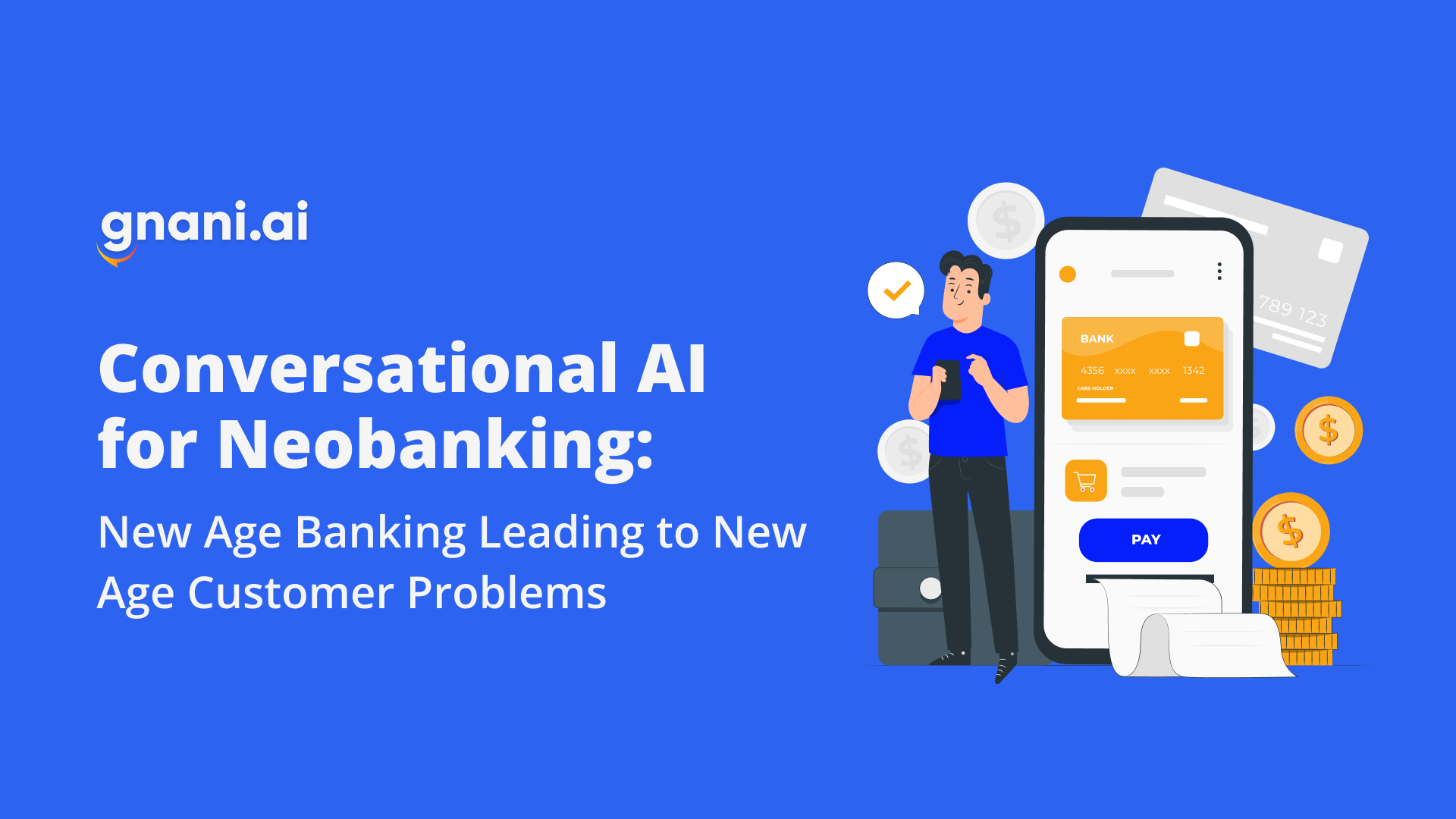Using Conversational AI and Chatbots to Transform the Neobanking Experience
Neobanking, a.k.a. challenger banks emerged from the mounting demand for easy and round-the-clock access to efficient banking processes. With no physical offices & branches, the level of precision, efficiency, and ability to handle load is a deal-breaker. These make Conversational AI and chatbots natural choices for creating the perfect Neo-Banking experience. They successfully enable Neo-Banks to run low-cost, easy-to-use, and digitally accessible services. Think of Neo-Banking and conversational AI like two peas in a pod.
Benefits of Using Convrsational AI in Banking and Financial Services
Traditionally, banks have relied on physical branches and call centers to provide customer support and handle transactions. However, the rise of neobanking has enabled customers to perform many banking tasks digitally through a mobile app or website.
There are several benefits of using conversational AI and chatbots in neobanking:
24/7 Support: One of the key benefits of using conversational AI and chatbots in neobanking is the ability to provide 24/7 support to customers. With chatbots, customers can get quick answers to their questions or resolve issues at any time of day without having to wait on hold or schedule an appointment at a physical branch. This improves the customer experience and frees up human staff to focus on more complex tasks.
Personalization: Another advantage of using conversational AI and chatbots in neobanking is the ability to personalize the customer experience. Chatbots can gather information about a customer’s preferences and history and use that data to provide personalized recommendations and solutions. For example, a chatbot might suggest a particular credit card or investment product based on a customer’s spending habits or financial goals.
Streamlined operations: The use of conversational AI and chatbots in neobanking can also help banks streamline their operations and save costs. By automating routine tasks and providing instant support to customers, chatbots can help banks reduce the need for human staff and lower overhead expenses.
Improved customer experience & customer loyalty: Chatbots can provide instant support and personalized recommendations, leading to a more convenient and enjoyable banking experience and help banks increase customer loyalty and retention by providing exceptional customer service and support.
As the neobanking industry grows and evolves, we will see more and more banks adopting these innovative solutions.
Challenges of Neobanking
As with life, no business is without its fair share of problems. Neobanking also faces unique challenges, albeit solvable hurdles. These challenges will only pave the way for further innovation as the industry matures.
So, what are some of the challenges that Neobanks are facing today?
Attrition of Differentiators
Neobanking is arguably the next significant innovation that challenges the traditional banking system. However, their success depends on how well they sustain the stack of differentiators that created their space in the first place. Factors such as digital distrust, limited services, security, and dependence on other financial institutions are watering down their key differentiators.
Regulation
The disparity in financial regulations across countries doesn’t make it any easier for Neo-Banks to make their mark. It obstructs them from entering and growing within specific markets. Neo-Banks need a robust regulatory framework and sound-proof digital banking license systems to deliver value for existing customers and expand.
Big Banks owning Neobanks
Although there is an appetite for Neobanking, legacy financial institutions continue to dominate the market. Large banking institutions pose an existential challenge to Neo-Banks because a) they have more resources and b) can bypass regulatory restrictions in many countries. For example, the acquisitions of Anytime Digital Bank by Orange bank and 86 by National Australia Bank have helped these financial juggernauts subdue competition and increase their customer base.
Impact of Covid-19
Neobanks have grown in popularity recently, and the COVID-19 pandemic has only accelerated this trend. However, it’s important to note that customer loyalty is not guaranteed in the neobanking industry. Many customers still prefer traditional banks that they are familiar with, and more than the limited services offered by neobanks may be needed to attract and retain customers. Neobanks may need to invest in technologies like reports and data analysis and expand their services to improve customer experience and increase loyalty.
Convincing Customers to Switch from Traditional Banking
Neobanks may struggle to gain customers’ trust who may be hesitant to switch to a digital banking only or may not be familiar with the new technology. From a global standpoint, users have been slow to adopt Neobanking. A report says that even among their most lucrative customers, i.e. millennials, only 3% have used Neobanking in the last 8 to 10 years. The journey of transitioning a customer towards Neobanking isn’t easy since the services offered are minimal as compared to legacy banks.
How can Conversational AI solve Neobanking Challenges?
Relevance is in the very DNA of Conversational AI. It syncs seamlessly with new technologies such as Neobanking. The shared objectives of increasing efficiency and convenience make conversational AI a natural choice to create the perfect customer experience. It enables Neobanks to run low-cost, easy-to-use, and digitally accessible services.
Credit Decisions
The old saying ‘Cash is King’ is dead. Credit is the new overlord in town! Over time, the use of plastic money became more dominant than cash. Conversational AI enables smarter assessments in the credit decision-making process. In other words, it helps facilitate responsible lending. Today, credit unions are open to accepting insights from Conversational AI to boost customer satisfaction (CSAT) and improve banking experience.
Risk Management
As an emerging banking solution, Neobanking must be extra cautious in risk management. It needs an improved mechanism to understand, predict, and protect against predictable or unpredictable risks. Conversational AI can forecast events, detect fraud, and analyze patterns to suggest contingency plans in the case of a threat.
Personalized Banking & Advice
Bill Gates once said that “Banking is necessary, banks are not.”
Neobanks emerged amidst the digital era when customers began to prefer personalization services and trusted advice. Several studies showed that over time, customers began to feel more comfortable interacting with chatbots and voice bots during the banking process.
Portfolio Management in Trading
Traders are constantly dealing with volatile markets, and conversational AI can help in providing technical analytics along with predictions to assist in assessing transaction costs. It can also break down big-sized trades into parts for better pricing options. Being available 24×7 and data load management are key advantages in this sector.
Speeds up the Process
The effectiveness of a neobank’s customer journey can be determined by how quickly issues are resolved, how many touch points are created, and the overall response rate. Conversational AI can help by collecting feedback at every stage and providing timely responses without relying on human intervention. This can help neobanks engage at-risk customers in real time and improve relationships using digital technology.
Collects Data
Data aggregation and analysis are crucial for understanding and improving customer journeys and neobanking processes. Voice bots and chatbots can analyze large amounts of customer conversation data to gain insights and deliver actionable recommendations.
Personalizes the Experience
It is important for businesses to think beyond just personalized messages. Today’s consumers are spoiled for choice with tailor-made services and products. Conversational AI can help with custom-made services and also create opportunities for personalization. They are designed to speak different languages and dialects, so catering to different demographics becomes a cakewalk.
The future of Neobanking
As neobanks work to improve their service offerings and products, it’s clear that conversational AI will be a valuable resource in achieving their goals. Using AI-powered voice bots and chatbots on various channels and platforms, neobanks can prioritize customer satisfaction and build loyalty. This can ultimately help them increase their market share over time. By utilizing digital solutions like conversational AI, neobanks can streamline their operations, reduce the need for human resources, and provide personalized and instant support to customers. To effectively implement these solutions, neobanks can use reports and data analysis to identify areas for improvement and make informed decisions about their use of conversational AI.
If you’re a Neobanking service provider who is looking to up their game, book a demo to see how Gnani.ai’s solutions can help create better experiences for your customers.
Frequently Asked Questions
What is conversational AI and how does it help transform the neobanking experience?
Conversational AI is the use of natural language processing and machine learning to enable computers to have conversations with humans. In neobanking, it helps enhance customer experience by providing 24/7 support, quick resolutions, and personalized services through chatbots.
Can chatbots in neobanking handle complex customer inquiries?
It depends on the sophistication of the chatbot. Advanced chatbots can handle a wide range of inquiries, while simple ones may only handle basic queries. Neobanks can continuously improve their chatbots with machine learning to better handle complex inquiries.
How do neobanks measure the success of their chatbot implementation?
Neobanks can measure the success of their chatbot implementation by tracking metrics such as customer satisfaction, resolution time, and the number of inquiries handled.





